Vegan Statistics By Country, Reasons, Demographics, Apparel Type, Concerns and Brands
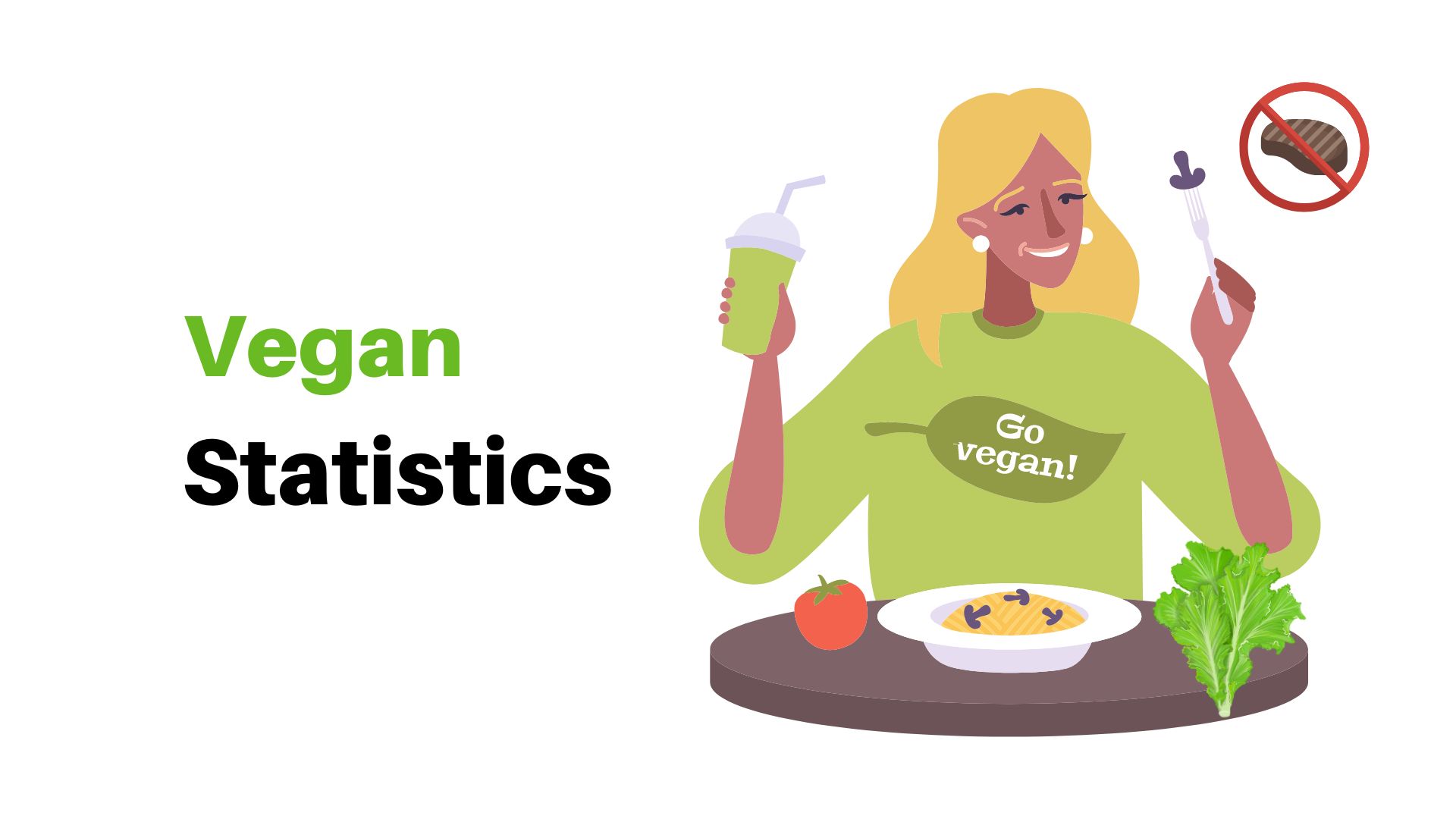
Page Contents
- Introduction
- Editor’s Choice
- Who are Vegans?
- Benefits of Being Vegan
- Types of Vegans
- Types of Vegan Diets
- Tips to Become Vegan
- General Vegan Statistics
- Vegan Statistics by Product
- Vegan Statistics by Reasons to Follow the Diet
- Vegan Statistics by Demographics
- Vegan Statistics by Apparel Type
- Vegan Statistics by Intentions to Continue the Diet
- Vegan Statistics by Concerns
- Vegan Statistics by Country
- Vegan Statistics by Brands
- Vegan Statistics by Perception
- Vegan Statistics by Total Vegan Restaurants Per 100,000 Residents
- Most popular Meat Alternatives Purchased by Americans
- Top 5 Easy Vegan-Friendly Recipes to Make at Home
- Conclusion
Introduction
Vegan Statistics: As they say, what we eat today decides our personality and future. If we are consuming healthy food, then our life expectancy increases. In the era of the pandemic, it is necessary to follow some kind of diet to keep the body healthy and increase immunity. Around the world, there are various types of vegans. Looking at the current number of vegans, it is expected that The Vegan Food market will increase at CAGR 6.4% by reaching $36.3 billion by 2030.
Check out these interesting Vegan Statistics gathered with current insights from around the globe.
Editor’s Choice
- In 2022, around 629,000 people have signed up for Veganuary from around the world. Out of which, 21% of the people participated for personal health reasons.
- By 2025, it is expected that the global Vegan market is expected to reach more than $22 billion.
- The year 2022 recorded 3x more growth in plant-based food sales compared to other years.
- Furthermore, in 2022, around 2 million Americans were completely following a vegan-based lifestyle.
- As of 2022, Asia Pacific was the largest market for Vegan foods and other products which was followed by Western Europe.
- Vegan Statistics show that 67% of Vegan diet followers are females while only 33% are males.
- 3% of the people started following the diet because they were influenced by some film.
- Studies show that African Americans are 48% more likely to shift to a Vegan lifestyle, whereas it is 46% for Asian Americans.
- Around the world, 40% of Vegan products were cheaper than regular products in the market.
- A household with a Vegan lifestyle spends 8% less on groceries compared to non-vegan households.
- Vegan Statistics state that, if the world decided to go Vegan then global farmland will be reduced by 75%.
- Vegan items are costlier at supermarkets compared to non-vegan items.
- The ingredients decide the cost of the total vegan food.
- Consumable vegan food requires around 300 gallons of water every day for production.
- According to Vegan Statistics, India ranks top for having the highest number of vegans as of 2022 resulting in 13%.
- The global dairy alternatives market is expected to grow at a CAGR of 16.7% by 2025.
- In the United States of America, around 1 million people have become vegan.
- Eating plant-based food lowers the gender-specific cancer rate by 34% in women.
- As of June 2022, Vegan Statistics state that in all generations, the number of vegetarians is more than vegans.
- If everyone converts to vegan, the greenhouse gases would be reduced by 70%, which would save $608 billion in economic value by 2050.
Who are Vegans?
Vegans follow a strict vegetarian diet, and they do not consume dairy products, honey, meat, eggs, or any other product produced by animals. Generally, different types of vegan diets include fruits, nuts, seeds, vegetables, grains, nuts, and legumes as common ingredients. Many vegans around the world also do not support products made out of leather, wool, fur, or silk. Moreover, drinks that are filtered using animal parts are also strictly No, such as beers, wines, and white sugars. The term vegan by coined by Donald Watson in 1944. National Vegan Day is observed every year in November.
Benefits of Being Vegan
- Eating plant-based food can help to reduce weight.
- Moreover, sugar levels in diabetes are controlled by reducing the A1C levels.
- Vegan food also reduces the chances of getting diagnosed with gender-based cancer.
- Plant-based food keeps the heart healthy.
- It increases life expectancy.
- Reduces the risk of stroke.
- Maintains the strength of the brain.
Types of Vegans
- Religious Vegans – These type of vegans is found mostly in culturally valued countries, where religion is given the most importance. The highest number of vegans are followers of Jainism in India whereas other types of people include Christians and Buddhists.
- Environmental Vegans – These types of people prefer plant-based food and avoid animal products. Certain types of vegan foods are avoided that do not reduce greenhouse gas emissions.
- Dietary Vegans – Dietary vegans do not eat animal foods and also avoid or limit the foods such as soda, oil, sugar, and fried foods. Moreover, other types of products such as apparel which are made of wool, silk, or leather are also not supported by these types of vegans.
- Ethical Vegans – Ethical Vegans carefully choose their food to avoid concerns for animals. Their focus is more on every individual animal.
Types of Vegan Diets
- High protein vegan diet – It includes lentils, beans, peanuts, soy products, protein powder, and other plant-based food such as oats, chia seeds, seitan, and quinoa.
- High-carb vegan diet – It includes non-starchy vegetables, legumes, and seeds.
- Raw vegan diet – People that follow a raw vegan diet eat seeds, vegetables, nuts, fruits herbs, and seeds. Moreover, other types of food are also consumed such as cakes, high-fat gourmet, and raw lasagna.
- Whole food plant-based diet – This type of diet includes seeds, nuts, legumes, veggies, fruits, and whole grains as primary consumption. Moreover, white bread, sugar, fried food, and frozen pizza are also consumed by this type of vegan.
- Varied vegan diet – Pizza, ice creams, salads, casseroles, and smoothies are consumed unless and until the ingredients are vegan.
- Freegan – These are part of ethically driven vegans and do not purchase animal-based products to not increase the demand for similar products.
- Ostovegans – This type of diet includes the consumption of oysters, mussels, scallops, and clams.
- Low-carb vegan diet – The low-card vegan diet has food consumption between 100 to 150 grams of carbs every day This type of diet is good for losing weight. It includes the consumption of plant-based foods.
- Additional types of vegan diets: Low-fiber, Gluten Free, Nut Free, Low FODMAP, Low Fiber, Soy-Free, and Low-protein.
Tips to Become Vegan
- Before turning to vegan research, the pros and cons and consult your doctor to take advice.
- Choose to become vegan with the most comfortable type of vegan diet. Do not go with the flow. All types of diets do not suit everyone.
- Visit hotels and restaurants that provide and promote vegan food.
- Join the global vegan network to meet up with people in a similar community.
- It may be difficult at the initial phase to consume vegan-based food only, but do not lose hope, good things take time.
- Try out new plant-based or vegan recipes at home. They are tasty!
- Stock up on some ready-to-eat, or easy-to-make vegan food meals at home.
- Plan your diet every day and follow the routine.
- Follow vegan creators on social media networks.
- Keep vegan substitutes at home to kill hunger.
- Vegan cheese is better than regular cheese.
- Consume plant-based protein.
General Vegan Statistics
- As of 2023, above 1,610 vegan-based products were launched for Veganuary 2023.
- According to Vegan Statistics, 98% of consumers are thinking of recommending Veganuary to their friends.
- As of 2022, around 9.7 million people in the United States of America are following a Vegan diet.
- Every year, 1 out of 3 people sign up for Veganuary, who want to eat more Vegan.
- People that follow a vegan lifestyle have a 15% lower mortality ratio.
- Eating plant-based food lowers the gender-specific cancer rate by 34% in women.
- Vegan Statistics state that eating plant-based food can lower the problems of blood pressure.
- Moreover, vegan Foods are low in fat as well as cholesterol and include high fiber.
- The global dairy alternatives market is expected to grow at a CAGR of 16.7% by 2025.
- Vegan Food is 65% more expensive than food with no dietary contents.
- Additionally, vegan items are costlier at supermarkets compared to non-vegan items.
- The ingredients decide the cost of the total vegan food.
- Furthermore, Vegan Statistics state that, becoming vegan from vegetarian can cost more than expected.
- Consumable vegan food requires around 300 gallons of water every day for production.
- Vegan Statistics state that, if the world decided to go Vegan then global farmland will be reduced by 75%.
- Moreover, if everyone converts to vegan, the greenhouse gases would be reduced by 70%, which would save $608 billion in economic value by 2050.
- The average age stated by Vegan Statistics to convert into Vegan is 24.1 years.
- Women are more likely to become vegan than men.
- In the United States of America, around 1 million people have become vegan.
- Vegan Statistics state that, as of today, the European region dominates the global Vegan food market, and it is likely to stay dominant by 2030.
- Similarly, it has been estimated that the global footwear market will reach $16.9 billion.
- 47% of the consumers in the United States of America purchased plant-based meat as of 2022.
- The estimated meat substitute market size in the United States of America by 2027 is $1.9 billion.
- Moreover, the estimated milk substitute market size in the United States of America is 3.1 billion by 2025.
- Vegan Statistics state that, around the globe, there are around 75,300,000 consumers of plant-based products.
- On January 1st, 2023, one person for every 2.4 seconds signed up for the Veganuary challenge to eat plant-based food for 31 days.
- The year 2022 recorded 3x more growth in plant-based food sales compared to other years.
- As of 2022, around 629,000 people have signed up for Veganuary from around the world. Out of which, 21% of the people participated for personal health reasons.
- Furthermore, in 2022, around 2 million Americans were completely following a vegan-based lifestyle.
- As of 2023, there are around 88 million people who are following Veganism.
- 94% of Americans prefer to eat more fruits and vegetables throughout the day.
- Women who follow a Vegan lifestyle are 34% less likely to be diagnosed with cancer.
- Moreover, shifting to plant proteins from eggs reduces the risk of death by 19%.
- People with plant-based diet lifestyles experience healthier body mass indexes.
- For every 2.4 seconds a person signed up for Veganuary on 1st January 2023.
- By 2025, it is expected that the global Vegan market is expected to reach more than $22 billion.
- A household with a Vegan lifestyle spends 8% less on groceries compared to non-vegan households.
- Studies show that, if a Vegan lifestyle is adopted, then it could save around 76% of agricultural land use as well as decrease greenhouse gas emissions by 50%.
- By 2029, the Vegan Footwear market is expected to reach around $46 billion, whereas the faux-leather industry will reach $35 billion by the same year.
- According to Vegan Statistics, there are more than 65,000 products registered as Vegan Friendly.
- As of 2022, Asia Pacific was the largest market for Vegan foods and other products which was followed by Western Europe.
- The Vegan Milk Product market is expected to cross $21 billion by 2024.
- Around the world, 40% of Vegan products were cheaper than regular products in the market.
- Around 48% of people are using dairy alternatives.
- In the coming years, Vegan Footwear is estimated to reach $24.86 billion, whereas Vegan Leather Industry is projected to reach $89.6 billion by 2025.
Vegan Statistics by Product
- Plant-based milk – 81%
- Dairy product substitutes – 48%
- Plant-based meat alternatives – 44%
- Vegan egg substitutes – 25%
- Plant-based condiments – 24%
- Other – 5%
Of people who follow a Vegan diet, 81% of them drink plant-based milk.
- Whereas, 48% of them consume substitutes for dairy products, while 44% of people choose plant-based meat alternatives.
- 25% and 24% of people consume Vegan egg substitutes and plan-based condiments respectively.
- 5% of the people choose other products.
(Source: worldanimalfoundation.org)
Vegan Statistics by Reasons to Follow the Diet
- 3% of the people started following the diet because they were influenced by some film.
- Whereas, 17% said they were influenced by someone of their acquaintance.
- 2% supported social media whereas 11.2% started it on their own.
- While others stated based on the book (3.4%), activism (1.4%), public speaker (1.3%) and media (1%).
- Some people started because of some kind of challenges whereas 0.17% of people were raised in a Vegan lifestyle.
- 4% and 9.7% of consumers did it for the purpose of their personal health and environment respectively.
Vegan Statistics by Demographics
- Vegan Statistics show that 67% of Vegan diet followers are females while only 33% are males.
- The average Vegan diet follower earns less than $30,000 a year.
- Studies show that African Americans are 48% more likely to shift to a Vegan lifestyle, whereas it is 46% for Asian Americans.
- In the United States of America, 3 out of 4 females shift to Vegan diets.
- In the United States of America, only 22% of males are vegan compared to 785 of females.
- 1 out of 2 black Americans follows a strict vegan lifestyle.
By Generation
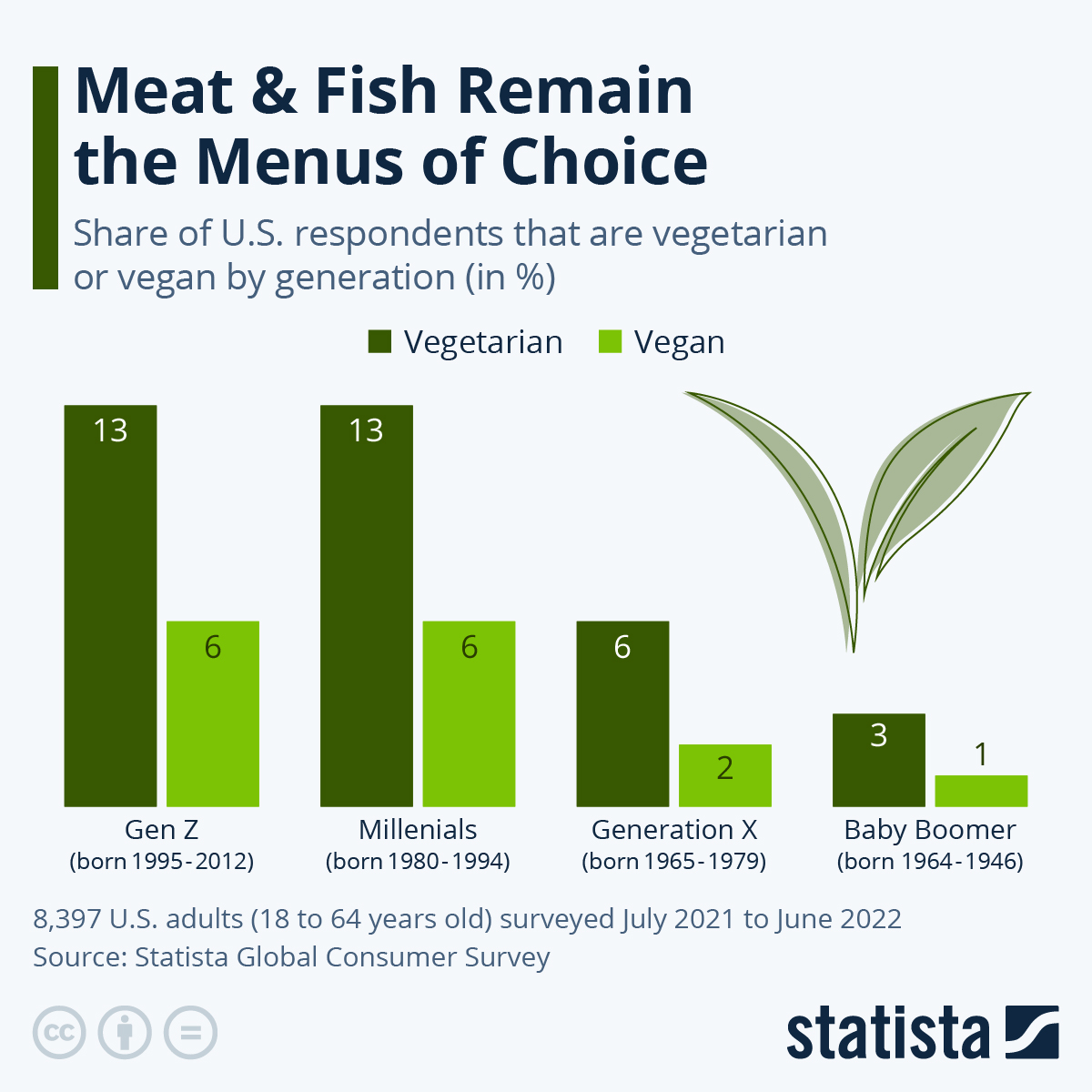
(Source: Statista.com)
- As of June 2022, Vegan Statistics state that in all generations, the number of vegetarians is more than vegans.
- In Gen Z there are 13% of vegetarians while 6% are vegans.
- There are 13% of vegetarians and 6% of vegans millennials.
- Moreover, 6% of vegetarians and 2% of vegans are found in Gen X.
- And only 3% of vegetarians and 1% of vegans contribute to the baby boomers club.
By Ethnicity
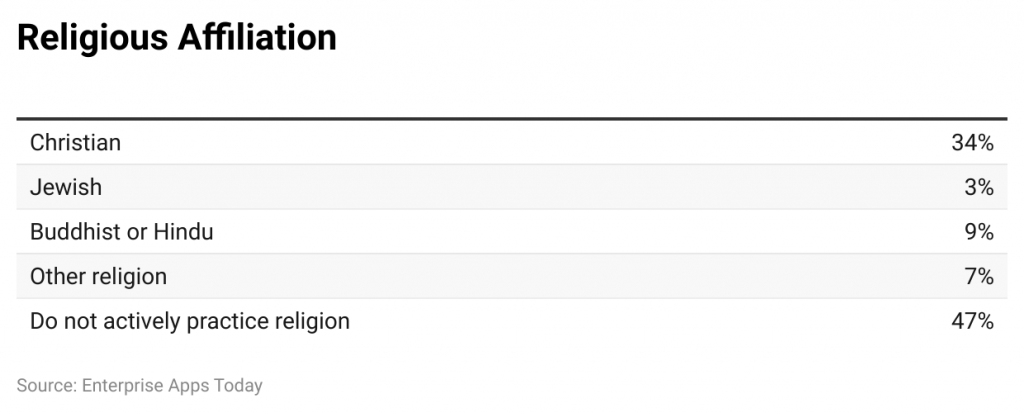
(Reference: veganbits.com)
- 34% of the people who are following a vegan diet are Christian while 9% are Hindu or Buddhist.
- 3% and 7% belong to Jewish and other religious backgrounds respectively.
- 47% of the people have not disclosed information about their ethnic background.
By Income Level
| Under $50,000 | 7% |
| $50,000 – $75,000 | 2% |
| $75,000 – $100,000 | %1 |
| Over $100,000 | 2% |
(Source: veganbits.com)
- Considering the Vegan Statistics by demographic, as of 2022, in the United States of America the highest number of vegans earn less than $50,000 per year resulting in 7%.
- Whereas 2% of the people similarly fall into the salary brackets between $50,000 to $75,000 and $100,000 and above.
- There are only 1% of US consumers are vegans and earn between $75,000 to $100,000.
By Age
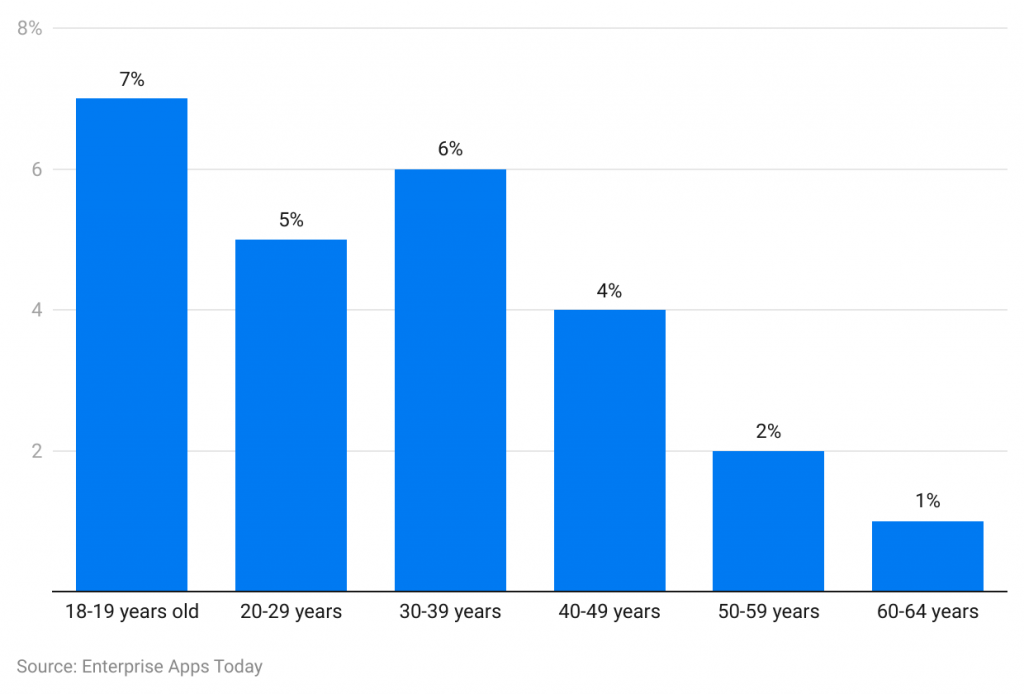
(Reference: statista.com)
- In 2022, in the United States of America, the highest number of Vegan diet followers belongs to the age group of 18 to 19 years resulting in 7%.
- Whereas, there are 5% of people aged between 20 to 29 years.
- There are 6% and 4% of consumers in 30 to 39 years and 40 to 49 years respectively.
- While the lowest number of Vegan diet followers belong to the 50 to 59 years and 60 to 64 years age group resulting in 2% and 1% respectively.
- As of 2023, in the United States of America, 36% of vegans belong to the 16 to 24 years of age group.
- The highest number of vegans are between 25 to 34 years resulting in 44%.
- There are 11% and 7% plant-based product consumers between the age groups of 35 to 44 years and 45 to 54 years respectively.
- And there are only 2% of consumers turned to vegan aged 55 years and above.
Vegan Statistics by Apparel Type
- The estimated value of the global ethical fashion market is $7.5 billion by 2027.
- Furthermore, it has been projected that the women’s vegan fashion market will reach $1.1 trillion by 2028.
- By 2025, it is expected that the revenue of the faux fur apparel market will be $28.4 billion.
- As of 2022, in the United States of America, the total number of faux fur clothing items purchased per capita was 0.07.
- Moreover, Vegan Statistics state that, the revenue of the worldwide non-animal leather clothing market along with footwear, apparel, and accessories in 2022 was more than $41 billion. It has been projected that it will experience a steady rise by 2025 reaching $49 billion.
Vegan Statistics by Intentions to Continue the Diet
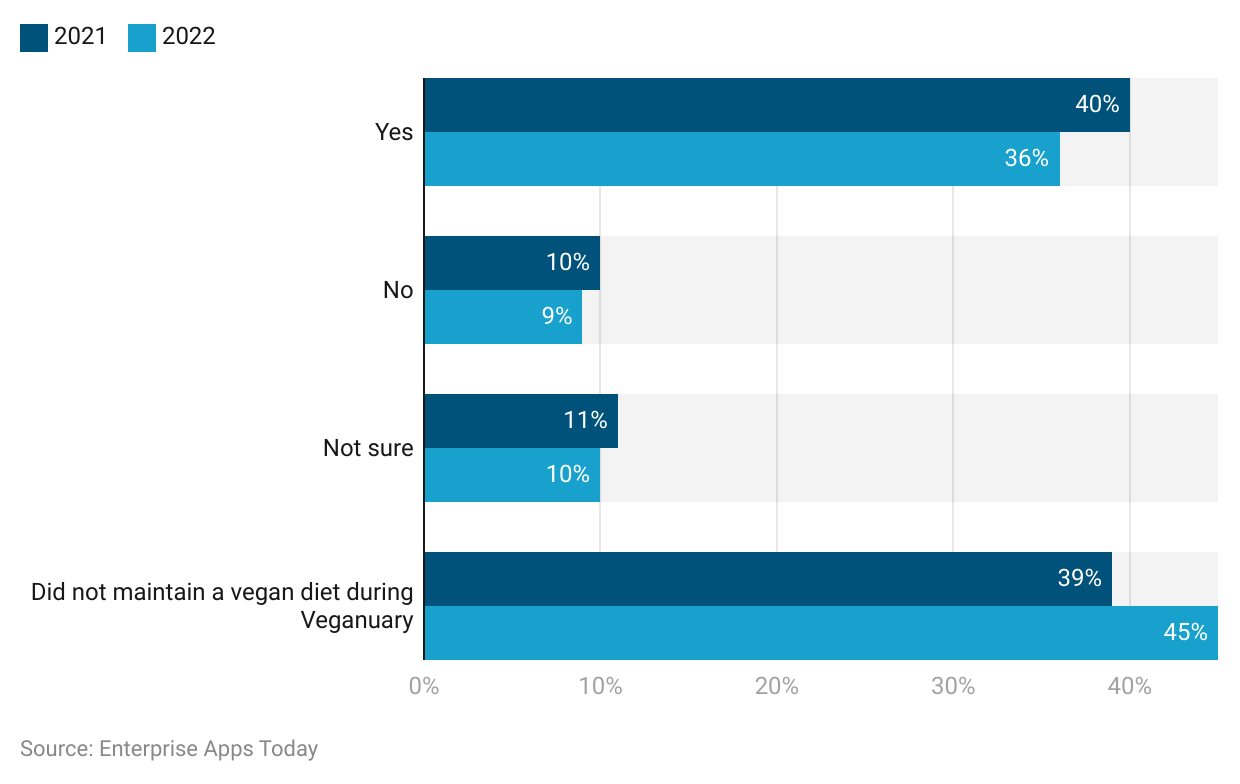
(Reference: Statista.com)
- As of 2022, there are 40% of consumers want to continue with their vegan diet, which resulted in 36% in 2021.
- Comparing to 9% of consumers who decided not to continue with their Vegan diet increased to 10% in 2022.
- 10% of the consumers in 2021 said they are not sure whether they want to continue with their diet, and this trend increased to 11% in 2022.
- During Veganuary Challenge in 2021, 45% of the people failed to do it while in 2022 there were only 39% of the people didn’t do it.
Vegan Statistics by Concerns
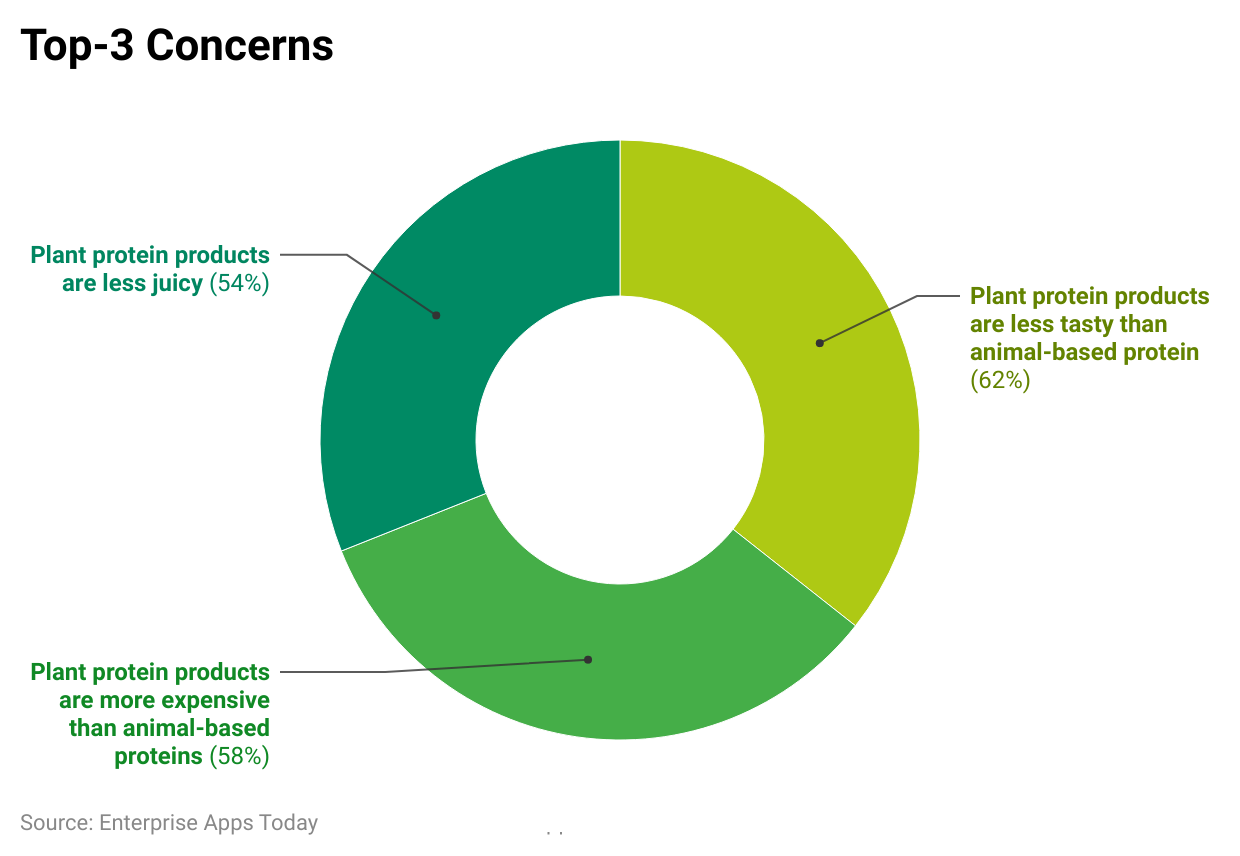
- The top concern for vegans is that plant protein products are less tasty than animal-based protein as stated by 62% of Americans.
- Whereas 58% of the consumers state that plant protein products are more expensive than animal-based proteins.
- And 54% of plant-based consumer state, plant protein products are less juicy.
Vegan Statistics by Country
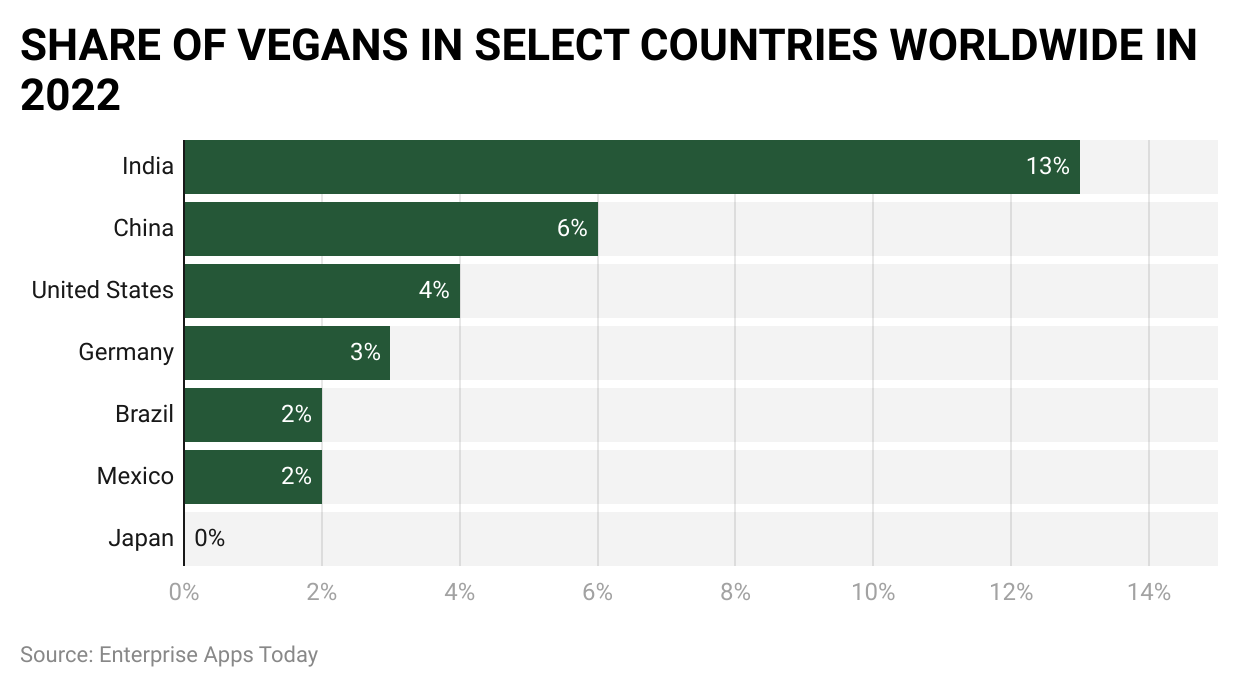
(Reference: worldanimalfoundation.org)
- According to Vegan Statistics, India ranks top for having the highest number of vegans as of 2022 resulting in 13%.
- China and the United States of America rank respectively at 6% and 4% of the share.
- There are only 3% of people in Germany follow a vegan lifestyle.
- Brazil and Mexico share a similar rate of vegans as of 2022 resulting respectively in 2%.
Vegan Statistics by Brands
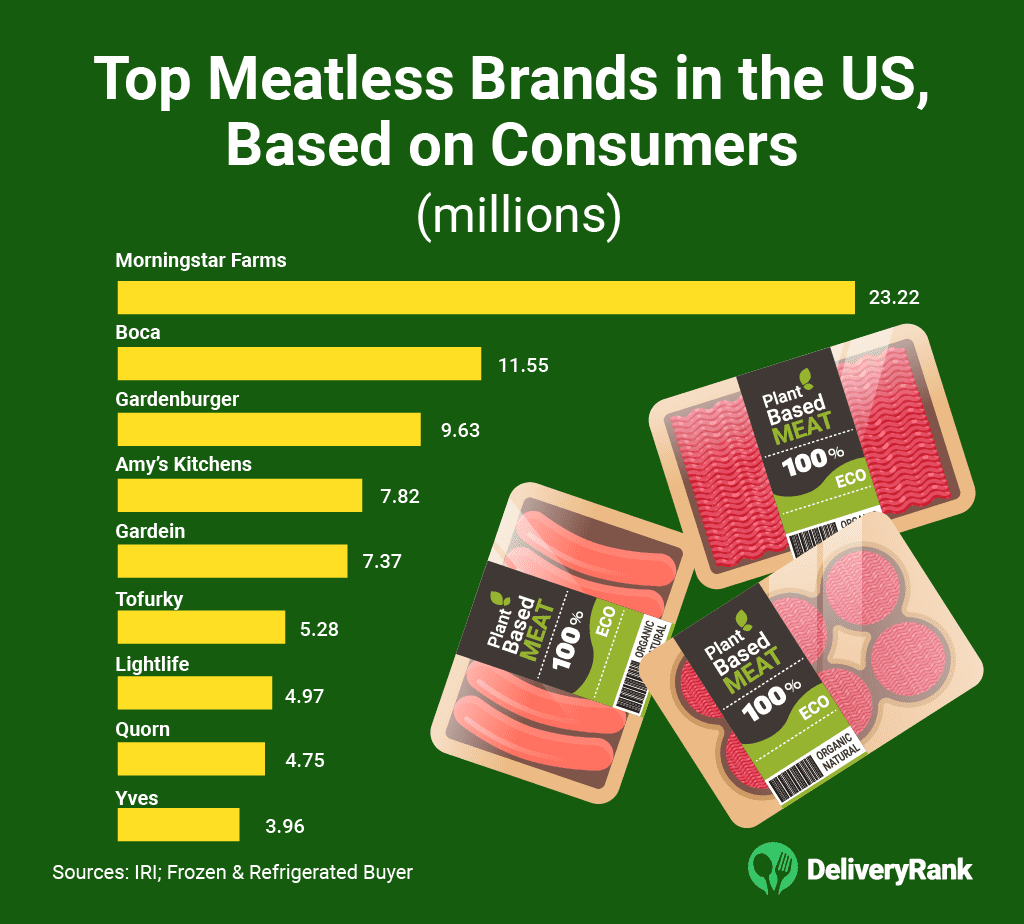
(Source: deliveryrank.com)
Vegan Statistics by Perception
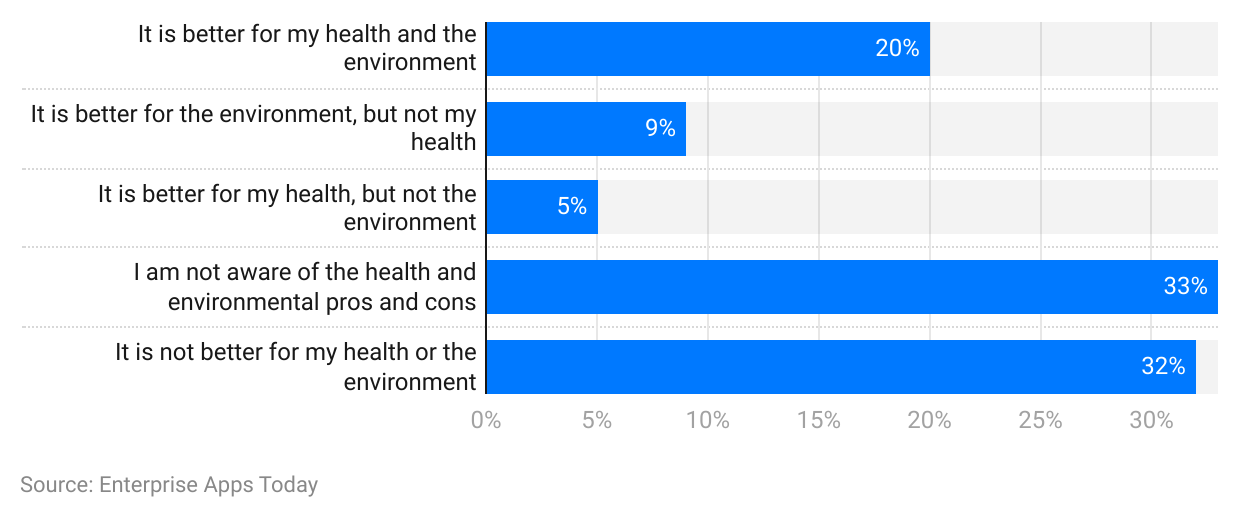
(Reference: Statista.com)
- As of 2022, 20% of Americans state that plant-based meat is better for health as well as the environment.
- Whereas 9% have a mind that it is better for the environment but not health.
- 5% of Americans state the opposite by saying it is better for health but not for the environment.
- On the other hand, 33% of Americans are not aware of the health and environmental pros and cons.
- And, 32% of the consumers in America say that plant-based meat is not better for health or the environment.
Vegan Statistics by Total Vegan Restaurants Per 100,000 Residents
By Highest
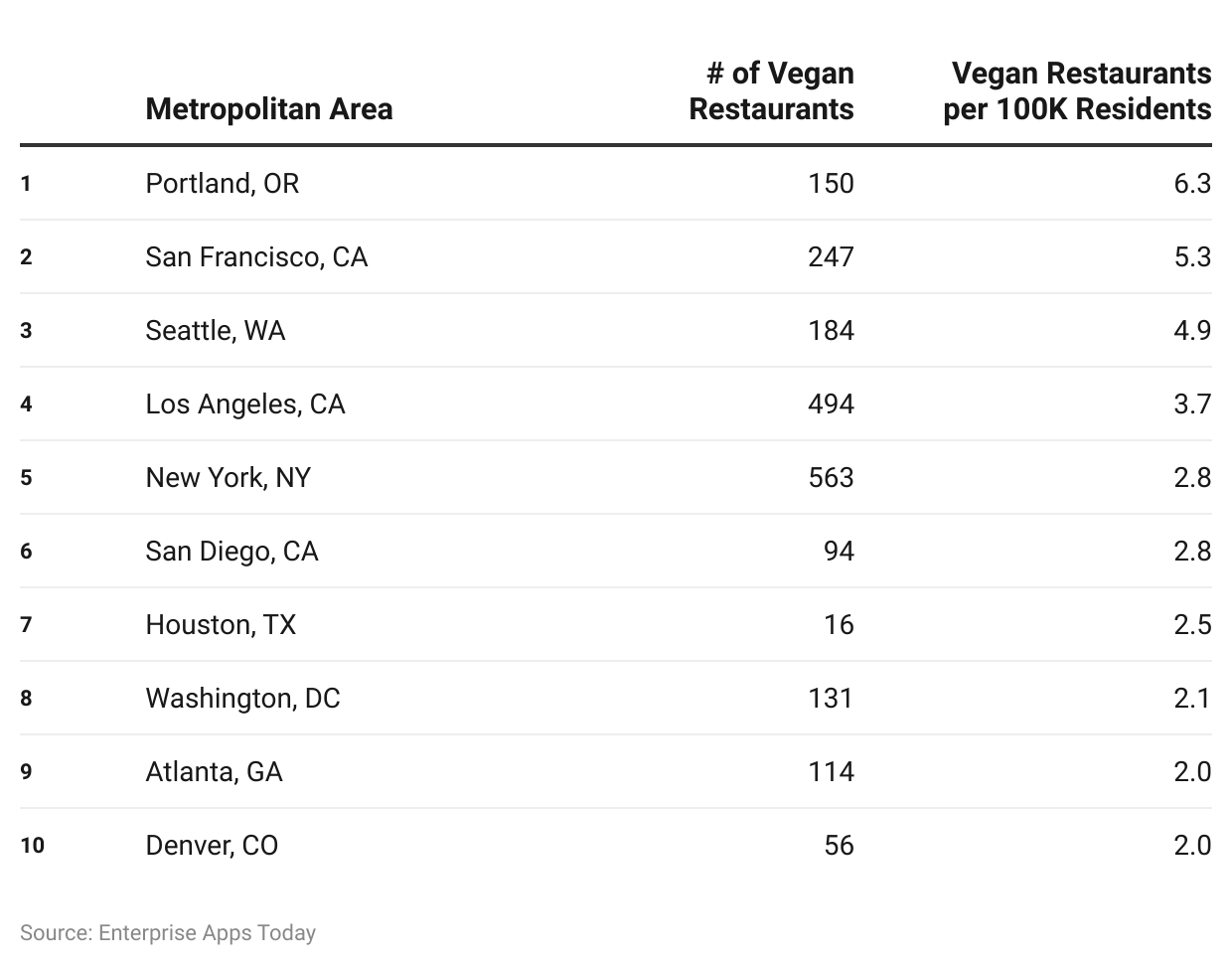
(Reference: veganbits.com)
By Lowest
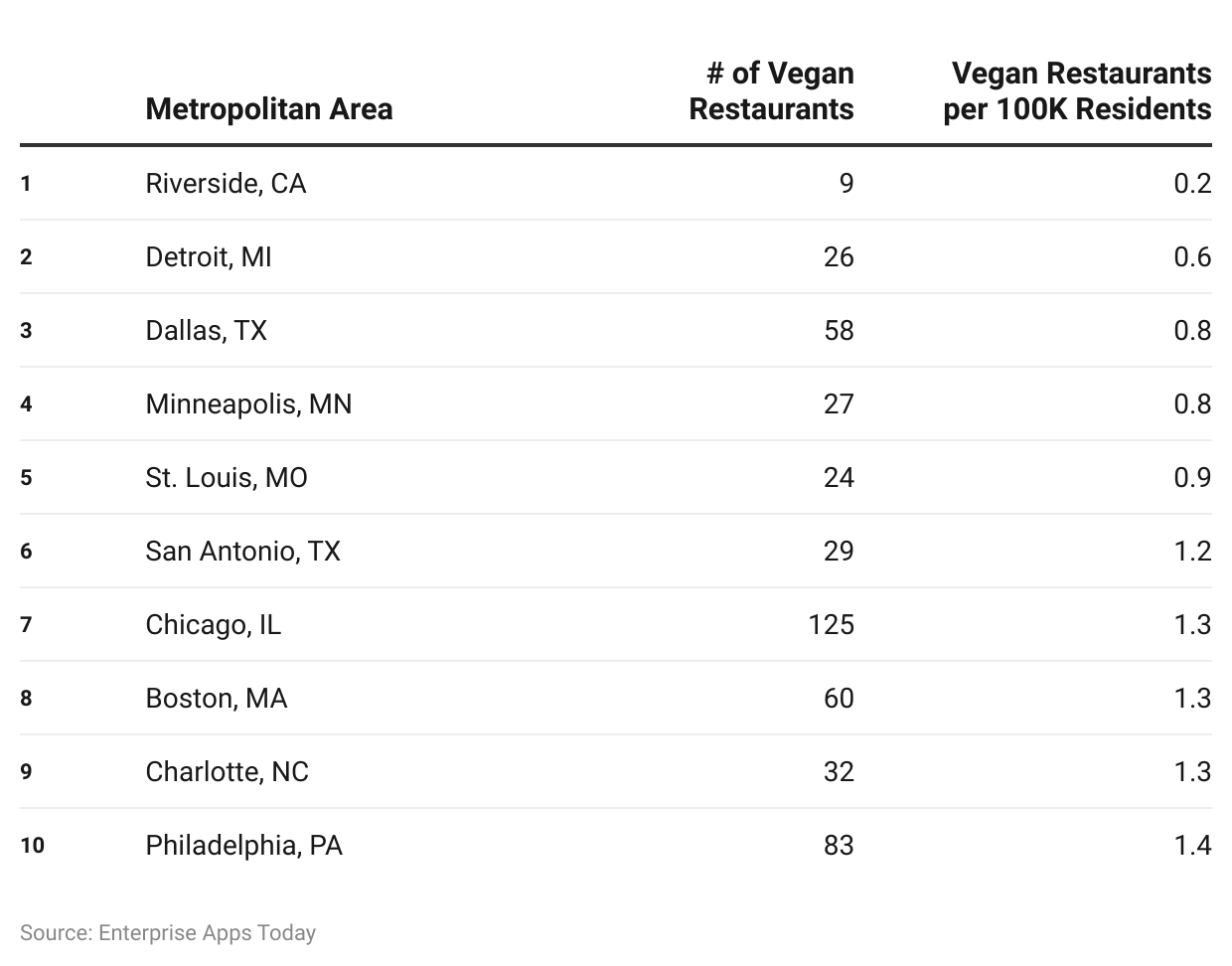
(Reference: veganbits.com)
Most popular Meat Alternatives Purchased by Americans
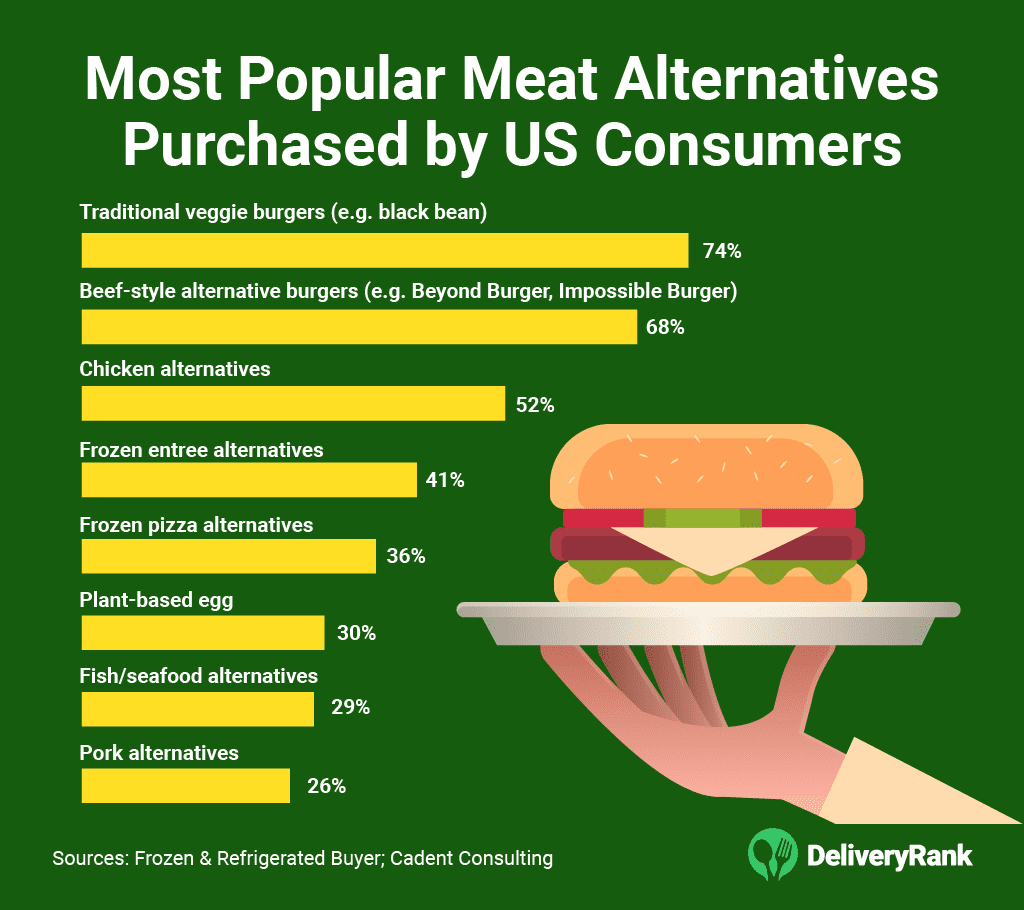
(Source: deliveryrank.com)
Top 5 Easy Vegan-Friendly Recipes to Make at Home
#1. Vegan Chickpea Curry
Ingredients:
- 1 tablespoon olive oil
- 1 medium onion, diced
- 3 cloves of garlic, minced
- 1 tablespoon curry powder
- 1 teaspoon ground cumin
- 1 can (14 ounces) diced tomatoes
- 1 can (14 ounces) of coconut milk
- 2 cups cooked chickpeas
- Salt and pepper to taste
- Fresh cilantro, for garnish (optional)
- Cooked rice, for serving
Instructions:
- Heat olive oil in a large skillet over medium heat. Add the diced onion and minced garlic. Sauté until the onion becomes translucent.
- Add curry powder and ground cumin to the skillet. Stir and cook for about a minute to release the flavours.
- Pour in the diced tomatoes (with their juice) and coconut milk. Stir well to combine.
- Add the cooked chickpeas to the skillet. Season with salt and pepper. Stir to coat the chickpeas in the curry sauce.
- Reduce the heat to low and simmer for about 10-15 minutes to allow the flavours to meld together and the sauce to thicken slightly.
- Serve the vegan chickpea curry over cooked rice. Garnish with fresh cilantro, if desired.
#2. Vegan Lentil Tacos
Ingredients:
- 1 tablespoon olive oil
- 1 medium onion, diced
- 2 cloves of garlic, minced
- 1 cup cooked lentils
- 1 tablespoon chilli powder
- 1 teaspoon ground cumin
- 1 teaspoon smoked paprika
- Salt and pepper to taste
- Taco shells or tortillas
- Toppings of your choice (e.g., diced tomatoes, shredded lettuce, avocado, salsa, etc.)
Instructions:
- Heat olive oil in a skillet over medium heat. Add diced onion and minced garlic. Sauté until the onion turns soft and translucent.
- Stir in the cooked lentils, chilli powder, ground cumin, smoked paprika, salt, and pepper. Cook for about 5 minutes to allow the flavours to meld together.
- Warm up the taco shells or tortillas according to package instructions.
- Fill the taco shells or tortillas with the lentil mixture. Top with your desired toppings.
#3. Vegan Sweet Potato and Black Bean Chili
Ingredients:
- 1 tablespoon olive oil
- 1 medium onion, diced
- 2 cloves of garlic, minced
- 2 medium sweet potatoes, peeled and diced
- 1 can (14 ounces) diced tomatoes
- 1 can (14 ounces) of black beans, rinsed and drained
- 2 cups vegetable broth
- 1 tablespoon chilli powder
- 1 teaspoon ground cumin
- Salt and pepper to taste
- Fresh cilantro, for garnish (optional)
Instructions:
- Heat olive oil in a large pot over medium heat. Add diced onion and minced garlic. Sauté until the onion becomes translucent.
- Add diced sweet potatoes, diced tomatoes, black beans, vegetable broth, chilli powder, ground cumin, salt, and pepper to the pot. Stir well to combine.
- Bring the mixture to a boil, then reduce the heat to low. Cover and simmer for about 20-25 minutes until the sweet potatoes are tender.
- Taste and adjust the seasonings if needed.
- Serve the sweet potato and black bean chilli hot. Garnish with fresh cilantro, if desired.
#4. Vegan Spaghetti Aglio e Olio
Ingredients:
- 8 ounces spaghetti (or any pasta of your choice)
- 1/4 cup olive oil
- 4 cloves of garlic, thinly sliced
Instructions
- Cook the spaghetti according to the package instructions until al dente. Drain and set aside.
- In a large skillet, heat olive oil over medium heat. Add the thinly sliced garlic and cook until it turns golden brown and crispy, stirring frequently. Be careful not to burn it.
- Remove the skillet from heat and add the cooked spaghetti to the skillet with the garlic oil. Toss well to coat the pasta evenly.
- Season with salt and pepper to taste. You can also add some red pepper flakes for a spicy kick if desired.
- Serve the vegan spaghetti aglio e olio hot, garnished with fresh parsley or basil, if desired.
#5. Vegan Stir-Fried Tofu and Vegetables
Ingredients:
- 14 ounces firm tofu, drained and cubed
- 2 tablespoons soy sauce
- 2 tablespoons sesame oil
- 2 cloves of garlic, minced
- 1 tablespoon grated fresh ginger
- 1 medium bell pepper, sliced
- 1 medium carrot, julienned
- 1 cup broccoli florets
- 1 cup snap peas
- Salt and pepper to taste
- Cooked rice or noodles, for serving
Instructions:
- In a bowl, combine the cubed tofu, soy sauce, and sesame oil. Gently toss to coat the tofu. Set aside and let it marinate for 10-15 minutes.
- Heat a tablespoon of sesame oil in a large skillet or wok over medium-high heat. Add the minced garlic and grated ginger. Sauté for a minute until fragrant.
- Add the marinated tofu to the skillet and cook until it turns golden brown on all sides. Remove the tofu from the skillet and set aside.
- In the same skillet, add the sliced bell pepper, julienned carrot, broccoli florets, and snap peas. Stir-fry for about 5-7 minutes until the vegetables are tender-crisp.
- Return the tofu to the skillet with the vegetables. Season with salt and pepper to taste. Stir-fry for an additional 2-3 minutes to heat everything through.
- Serve the stir-fried tofu and vegetables over cooked rice or noodles.
Conclusion
While it seems difficult to convert to vegan, it is stress-free. Slowly the world is adopting to plant-based diet lifestyle. And it is benefiting the majority of the people. You could add ‘to become vegan’ to your new year’s resolution list. Rather than eating junk food, harming our environment, and killing animals, becoming vegan is a good choice. It’s like a win-win situation. You get to live a healthy lifestyle and our environment is protected. Take advantage of the internet, and search for Vegan or plant-based food information. Try out recipes that motivate you!
Sources
FAQ.
A vegan follows a stricter vegetarian diet by avoiding eggs, dairy products, and other food items processed using animals. Whereas, a vegetarian does not eat any animal flesh, fish, or poultry products, but they consume dairy products.
Vegan-friendly stores in the United States of America are 1. H-E-B 2. Harris Teeter 3. Stop and Shop 4. Hy-Vee 5.Safeway 6.Kroger 7.Publix 8. Fred Meyer 9. Target 10.Wegmans 11. Shop Rite 12.Giant Food 13.Ralphs 14.King Soopers and Whole Foods Market.
Moreover, other stores that provide online delivery in the United States of America are 1.BESTIES Vegan Paradise 2.The Vegetarian Site 3.NoPigNeva 4.PlantX 5.Plant-Based Grocery 6.Vegan Quesst 7.VEDGEco 8. Thrive Market 9.Hungryroot 10.Imperfect Foods 11.Instacrt and 12.Amazon Fresh.
Texas (18.945), New York (20,346), and California (31,957) have the highest number of Vegan/Vegetarian restaurants.

By conducting scientific research, I write about illness, health and healthcare. As a professional medical writer, my experience includes creating feature articles for newsletters and websites as well as research news stories for doctors and researchers. Reading has been an integral part of me since childhood - I'm fan of "Friends" and the "Harry Potter series". Before this career, I was employed by a French multinational company. However, my passion for reading led me to pursue writing professionally; my first Amazon-published short story entitled "The envelope that changed our lives" has recently been released. In my free moments, I enjoy long bike rides around town.